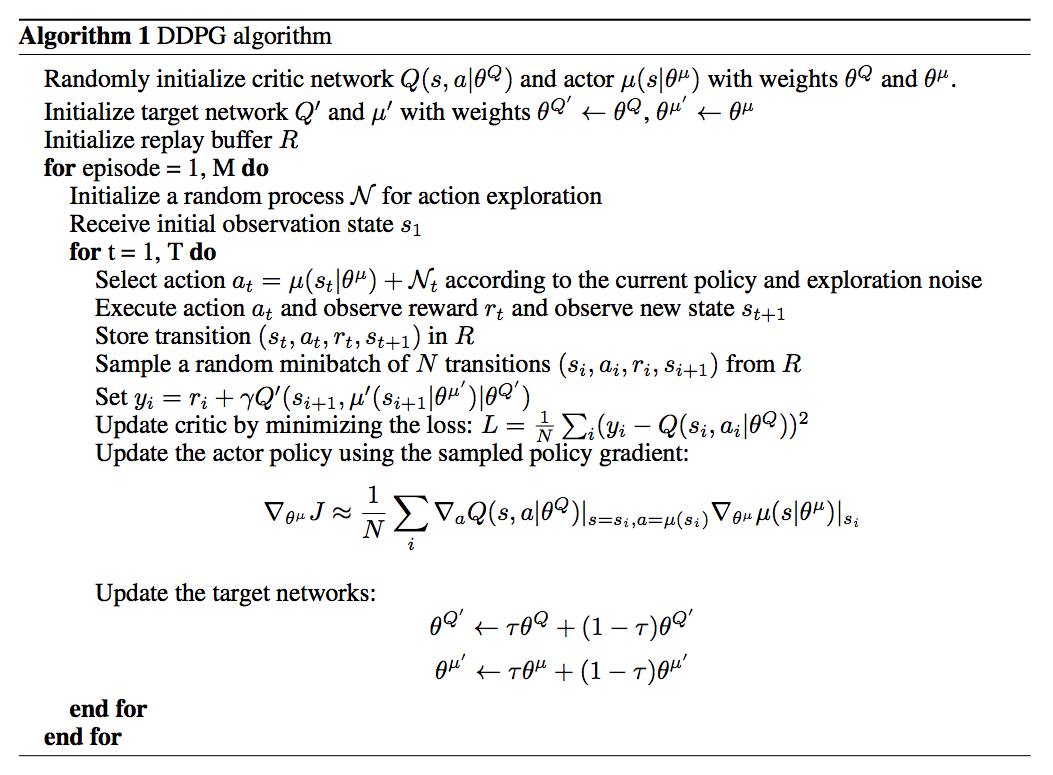ddpg输出的不是行为的概率, 而是具体的行为, 用于连续动作 (continuous action) 的预测

代码实现的gym的pendulum游戏,这个游戏是连续动作的

""" Deep Deterministic Policy Gradient (DDPG), Reinforcement Learning. DDPG is Actor Critic based algorithm. Pendulum example. View more on my tutorial page: https://morvanzhou.github.io/tutorials/ Using: tensorflow 1.0 gym 0.8.0 """ import tensorflow as tf import numpy as np import gym import time np.random.seed(1) tf.set_random_seed(1) ##################### hyper parameters #################### MAX_EPISODES = 200 MAX_EP_STEPS = 200 lr_a = 0.001 # learning rate for actor lr_c = 0.001 # learning rate for critic gamma = 0.9 # reward discount REPLACEMENT = [ dict(name='soft', tau=0.01), dict(name='hard', rep_iter_a=600, rep_iter_c=500) ][0] # you can try different target replacement strategies MEMORY_CAPACITY = 10000 BATCH_SIZE = 32 RENDER = True OUTPUT_GRAPH = True ENV_NAME = 'Pendulum-v0' ############################### Actor #################################### class Actor(object): def __init__(self, sess, action_dim, action_bound, learning_rate, replacement): self.sess = sess self.a_dim = action_dim self.action_bound = action_bound self.lr = learning_rate self.replacement = replacement self.t_replace_counter = 0 with tf.variable_scope('Actor'): # 这个网络用于及时更新参数 # input s, output a self.a = self._build_net(S, scope='eval_net', trainable=True) ##这个网络不及时更新参数, 用于预测action # input s_, output a, get a_ for critic self.a_ = self._build_net(S_, scope='target_net', trainable=False) self.e_params = tf.get_collection(tf.GraphKeys.GLOBAL_VARIABLES, scope='Actor/eval_net') self.t_params = tf.get_collection(tf.GraphKeys.GLOBAL_VARIABLES, scope='Actor/target_net') if self.replacement['name'] == 'hard': self.t_replace_counter = 0 self.hard_replace = [tf.assign(t, e) for t, e in zip(self.t_params, self.e_params)] else: self.soft_replace = [tf.assign(t, (1 - self.replacement['tau']) * t + self.replacement['tau'] * e) for t, e in zip(self.t_params, self.e_params)] def _build_net(self, s, scope, trainable):#根据state预测action的网络 with tf.variable_scope(scope): init_w = tf.random_normal_initializer(0., 0.3) init_b = tf.constant_initializer(0.1) net = tf.layers.dense(s, 30, activation=tf.nn.relu, kernel_initializer=init_w, bias_initializer=init_b, name='l1', trainable=trainable) with tf.variable_scope('a'): actions = tf.layers.dense(net, self.a_dim, activation=tf.nn.tanh, kernel_initializer=init_w, bias_initializer=init_b, name='a', trainable=trainable) scaled_a = tf.multiply(actions, self.action_bound, name='scaled_a') # Scale output to -action_bound to action_bound return scaled_a def learn(self, s): # batch update self.sess.run(self.train_op, feed_dict={S: s}) if self.replacement['name'] == 'soft': self.sess.run(self.soft_replace) else: if self.t_replace_counter % self.replacement['rep_iter_a'] == 0: self.sess.run(self.hard_replace) self.t_replace_counter += 1 def choose_action(self, s): s = s[np.newaxis, :] # single state return self.sess.run(self.a, feed_dict={S: s})[0] # single action def add_grad_to_graph(self, a_grads): with tf.variable_scope('policy_grads'): # ys = policy; # xs = policy's parameters; # a_grads = the gradients of the policy to get more Q # tf.gradients will calculate dys/dxs with a initial gradients for ys, so this is dq/da * da/dparams self.policy_grads = tf.gradients(ys=self.a, xs=self.e_params, grad_ys=a_grads) with tf.variable_scope('A_train'): opt = tf.train.AdamOptimizer(-self.lr) # (- learning rate) for ascent policy self.train_op = opt.apply_gradients(zip(self.policy_grads, self.e_params))#对eval_net的参数更新 ############################### Critic #################################### class Critic(object): def __init__(self, sess, state_dim, action_dim, learning_rate, gamma, replacement, a, a_): self.sess = sess self.s_dim = state_dim self.a_dim = action_dim self.lr = learning_rate self.gamma = gamma self.replacement = replacement with tf.variable_scope('Critic'): # Input (s, a), output q self.a = tf.stop_gradient(a) # stop critic update flows to actor # 这个网络用于及时更新参数 self.q = self._build_net(S, self.a, 'eval_net', trainable=True) # 这个网络不及时更新参数, 用于评价actor # Input (s_, a_), output q_ for q_target self.q_ = self._build_net(S_, a_, 'target_net', trainable=False) # target_q is based on a_ from Actor's target_net self.e_params = tf.get_collection(tf.GraphKeys.GLOBAL_VARIABLES, scope='Critic/eval_net') self.t_params = tf.get_collection(tf.GraphKeys.GLOBAL_VARIABLES, scope='Critic/target_net') with tf.variable_scope('target_q'): self.target_q = R + self.gamma * self.q_#target计算 with tf.variable_scope('TD_error'): self.loss = tf.reduce_mean(tf.squared_difference(self.target_q, self.q))#计算loss with tf.variable_scope('C_train'): self.train_op = tf.train.AdamOptimizer(self.lr).minimize(self.loss)#训练 with tf.variable_scope('a_grad'): self.a_grads = tf.gradients(self.q, a)[0] # tensor of gradients of each sample (None, a_dim) if self.replacement['name'] == 'hard': self.t_replace_counter = 0 self.hard_replacement = [tf.assign(t, e) for t, e in zip(self.t_params, self.e_params)] else: self.soft_replacement = [tf.assign(t, (1 - self.replacement['tau']) * t + self.replacement['tau'] * e) for t, e in zip(self.t_params, self.e_params)] def _build_net(self, s, a, scope, trainable):#Q网络,计算Q(s,a) with tf.variable_scope(scope): init_w = tf.random_normal_initializer(0., 0.1) init_b = tf.constant_initializer(0.1) with tf.variable_scope('l1'): n_l1 = 30 w1_s = tf.get_variable('w1_s', [self.s_dim, n_l1], initializer=init_w, trainable=trainable) w1_a = tf.get_variable('w1_a', [self.a_dim, n_l1], initializer=init_w, trainable=trainable) b1 = tf.get_variable('b1', [1, n_l1], initializer=init_b, trainable=trainable) net = tf.nn.relu(tf.matmul(s, w1_s) + tf.matmul(a, w1_a) + b1) with tf.variable_scope('q'): q = tf.layers.dense(net, 1, kernel_initializer=init_w, bias_initializer=init_b, trainable=trainable) # Q(s,a) return q def learn(self, s, a, r, s_): self.sess.run(self.train_op, feed_dict={S: s, self.a: a, R: r, S_: s_}) if self.replacement['name'] == 'soft': self.sess.run(self.soft_replacement) else: if self.t_replace_counter % self.replacement['rep_iter_c'] == 0: self.sess.run(self.hard_replacement) self.t_replace_counter += 1 ##################### Memory #################### class Memory(object): def __init__(self, capacity, dims): self.capacity = capacity self.data = np.zeros((capacity, dims)) self.pointer = 0 def store_transition(self, s, a, r, s_): transition = np.hstack((s, a, [r], s_)) index = self.pointer % self.capacity # replace the old memory with new memory self.data[index, :] = transition self.pointer += 1 def sample(self, n): assert self.pointer >= self.capacity, 'Memory has not been fulfilled' indices = np.random.choice(self.capacity, size=n) return self.data[indices, :] import pdb; pdb.set_trace() env = gym.make(ENV_NAME) env = env.unwrapped env.seed(1) state_dim = env.observation_space.shape[0]#3 action_dim = env.action_space.shape[0]#1 连续动作,一维 action_bound = env.action_space.high#[2] # all placeholder for tf with tf.name_scope('S'): S = tf.placeholder(tf.float32, shape=[None, state_dim], name='s') with tf.name_scope('R'): R = tf.placeholder(tf.float32, [None, 1], name='r') with tf.name_scope('S_'): S_ = tf.placeholder(tf.float32, shape=[None, state_dim], name='s_') sess = tf.Session() # Create actor and critic. # They are actually connected to each other, details can be seen in tensorboard or in this picture: actor = Actor(sess, action_dim, action_bound, lr_a, REPLACEMENT) critic = Critic(sess, state_dim, action_dim, lr_c, gamma, REPLACEMENT, actor.a, actor.a_) actor.add_grad_to_graph(critic.a_grads)# # 将 critic 产出的 dQ/da 加入到 Actor 的 Graph 中去 sess.run(tf.global_variables_initializer()) M = Memory(MEMORY_CAPACITY, dims=2 * state_dim + action_dim + 1) if OUTPUT_GRAPH: tf.summary.FileWriter("logs/", sess.graph) var = 3 # control exploration t1 = time.time() for i in range(MAX_EPISODES): s = env.reset() ep_reward = 0 for j in range(MAX_EP_STEPS): if RENDER: env.render() # Add exploration noise a = actor.choose_action(s) a = np.clip(np.random.normal(a, var), -2, 2) # add randomness to action selection for exploration s_, r, done, info = env.step(a) M.store_transition(s, a, r / 10, s_) if M.pointer > MEMORY_CAPACITY: var *= .9995 # decay the action randomness b_M = M.sample(BATCH_SIZE) b_s = b_M[:, :state_dim] b_a = b_M[:, state_dim: state_dim + action_dim] b_r = b_M[:, -state_dim - 1: -state_dim] b_s_ = b_M[:, -state_dim:] critic.learn(b_s, b_a, b_r, b_s_) actor.learn(b_s) s = s_ ep_reward += r if j == MAX_EP_STEPS-1: print('Episode:', i, ' Reward: %i' % int(ep_reward), 'Explore: %.2f' % var, ) if ep_reward > -300: RENDER = True break print('Running time: ', time.time()-t1)